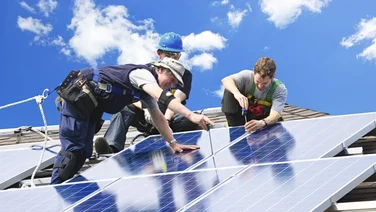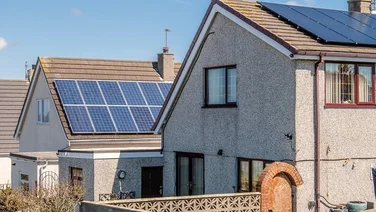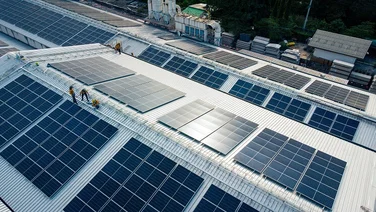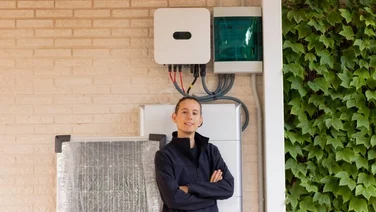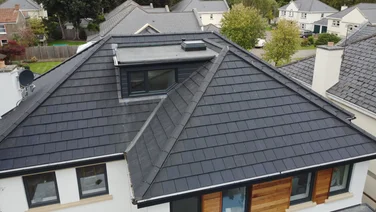A typical shed can fit one to three standard 350-watt solar panels
Solar panels cost £703 per panels, including installation
Flexible solar panels are a good option for sheds that cant hold much weight
Solar panels cost a fair bit of money, especially when being installed on a roof. But did you know there are other ways you can use them which might be cheaper, such as putting a few on your shed?
Whether its to power lights or tools in your shed, or just to supplement your homes electricity, there are plenty of ways to place solar panels on sheds. Weve got all the information on how to make this happen in this article.
Once youre ready to invest in solar panels, you can use our quick quote tool. All you have to do is provide a few details, and our expert installers will be in touch with free quotes for you to compare.
Where do you want to install solar panels?
Get started
Can you put solar panels on your shed?
Technically, you can put solar panels on any shed you just need to get a few things right to make sure theyre effective.
Solar panels are pretty hefty pieces of kit, which means the shed will need to be made from sturdy materials that can hold the weight. If your shed is made from flimsy material or is looking a bit worse for wear, it wont be a suitable home for solar panels.
Since the cost of solar panels is decreasing, you might be able to afford a decent-sized system but you need to make sure the shed has plenty of space for the panels.
When it comes to solar power generation, it all depends on how much energy you consume. Generally, even if you only have very small electricity requirements, you’ll still need at least two or three panels, which will measure roughly 1.6 square metres.
As for the angle and direction of the roof? You should make sure its at about 35 degrees, with the panels facing southwards, to make sure they have optimal efficiency (the amount of energy that can be converted from sunlight into electricity).
Installing the panels at this angle will also mean the rain will run off the panels and will avoid pooling. Itll also prevent debris from piling up.
If your sheds roof is at a different angle, you can still install solar panels, but they might not be as effective. Got yourself a shed with a flat roof? All you have to do is get a tilted-mounting system, which you can then place the panels onto.

Is your shed roof suitable for solar panels?
Whether your shed is suitable for solar panels depends on the material the shed roof is made of, the size of the shed, and whether there are any reinforcements under the roof.
The first point to consider is the size and strength of your shed roof.
Sheds made of wood wont typically be able to withstand more than 67 kg, metal shed roofs can around 12 kg, and plastic roofs cant withstand much weight at all, according to Garden Projects Advice. Most standard solar panels weigh about 18 kilograms (kg), making them too heavy for some sheds.
If youre worried your roof wont be strong enough for standard solar panels, you could always consider flexible solar panels. These bendy panels dont usually weigh more than 12 kg, and they come in smaller sizes than standard solar panels, which are around 2 square metres.
On the plus side, the bigger a shed is, the more weight it will be able to hold, regardless of the material. Garden Projects Advice says that if a shed is at least 3 square metres, it could withstand around 45 kg122 kg enough to support two to three standard solar panels.
This same logic applies to putting solar panels on a pergola, if you have one.
Where do you want to install solar panels?
Get startedHow many solar panels does your shed need?
The number of solar panels your shed needs depends on your personal goals.
Three standard 350-watt (W) solar panels, taking up 6 square metres, can produce enough electricity to meet the needs of a shed thats been converted into an office or studio.
If you want to install solar panels on your shed to produce supplemental electricity for your house, this same amount of solar panels will meet a little under 30% of the energy needs of the average three-bedroom house.
However, the number of solar panels you install will likely be dictated by how many solar panels your shed roof can safely hold.
Since most standard shed roofs are only 45 square metres, theyll probably only be able to fit two 350 W solar panels. This should still be enough to power small electrical equipment, such as lights, fans, or an electric radiator.
How much do shed solar panels cost?
One standard 350 W solar panel cost around £703 to buy and install. The average 45 square metres shed roof could fit a maximum of two solar panels, bringing the total cost to £1,405.
Flexible solar panels, on the other hand, cost £200 to £300 per square metre. The average shed roof could fit four flexible solar panels, for a total cost of around £1,120.
Overall, solar panel costs will vary, depending on the number of solar panels being installed. The more solar panels you install, the more expensive it will be. The make, model, and type of solar panel will also affect the cost.

Benefits of solar panels on a shed
There are many benefits to having solar panels on a shed, including:
- Being able to fully power the shed with solar panels
- Supplemental panels for your main solar panel system
- Partially powering other green appliances, such as electric cars or heat pumps
- Storing emergency power, in case of blackouts
- Keeping your houses appearance unchanged whilst benefiting from solar energy
- An easier installation process than roof-mounted solar panels
Fully power your shed
Have you transformed your shed into an office space, studio, workshop, or outdoor living space? Its likely that your shed will be consuming a lot of electricity then more than a shed thats used for just storing things, at least.
In this case, propping some solar panels on your roof will help power appliances and lighting, helping you cut back on costs.
You wont need a huge solar panel set either, a few panels will do the job but this will depend on how often you use it, how many appliances you need to power, and the wattage of each one.
Supplement an existing system on your houses roof
Adding panels to a garden shed is a great option for homeowners that would like to increase their solar capacity but have run out of space on their propertys roof for any more panels.
Solar panels are a long-term commitment usually lasting 25-30 years. Although this is one of the advantages of solar panels, homeowners electricity needs might change during this period just think back to how many more electric appliances we have now compared to 25 years ago.
Partially power other green appliances
If youve bought other green appliances over the years, such as an electric vehicle or a heat pump, you can partially power them using the solar panels on your shed roof.
You wont be able to fully power these green devices, since youd need more than just a couple of extra panels for that. For example, to charge an electric vehicle with solar panels youd typically need a system with about 10 solar panels.
But by partially powering an electric car or a heat pump with free green electricity, you can reduce the running costs of each appliance respectively, and lower your carbon footprint.
Take a look at our guide on air source heat pump costs to get an idea of how much you might spend.
Store emergency power
For anyone that lives in an area thats notoriously bad for power outages, storing extra solar power could come in handy.
Adding a set of solar panels onto a shed roof and pairing it with a solar battery can allow homeowners to store electricity for these situations.
Keep houses appearance the same
If youre hesitant about installing solar panels on the roof of your house because of aesthetic reasons, putting them on your shed can be a good compromise.
Whilst you might not be able to meet your homes energy needs with the 14 panels on your shed, its still a good way to start using more clean energy.
You can always decide to install solar panels on your roof at a later date, when you feel more comfortable with the idea. After all, solar panels are becoming more popular 69% of Brits say theyd rent or buy a property with solar panels, according to our National Home Energy Survey.
Easier installation process than mounting solar panels on a roof
Installing solar panels on a shed should be an easier process than installing them on the roof mainly because a shed roof is usually much closer to the ground, so its easier to access.
Less scaffolding (if any) will need to be set up in order to fix solar panels onto your shed roof, which means installation will take less time and cost less money.
How are solar panels installed on a shed?
Installing solar panels on a shed is a similar process to installing them on the roof of a house. If anything, its a little easier, since less scaffolding if any needs to be set up.
The installers will first check if the shed roof is strong enough to support solar panels. If it is, theyll proceed with installation.
Depending on how tall your shed is, they might need to put up minor scaffolding. The installers will then attach roof anchors and a mounting system to your shed, which will hold the panels securely.
Once the solar panels are fitted onto their mounting brackets, the installers will connect them to an inverter. This device converts the direct current (DC) electricity solar panels generate into alternating current (AC) electricity the kind used by your house and the grid.
The inverter is then connected to the propertys fuse box and generation metre, which will track how much electricity your solar panels generate. This will either be in your shed or your home, depending on the set up you currently have.
The installation should take around two days to complete.
Do you need planning permission to put solar panels on your shed?
You dont typically need planning permission for solar panels on a shed. There are some exceptions however, such as if you live in a listed building or conservation area.
Even if the solar panels arent going on the building itself, any renovation work done within the boundaries of a listed building or in a conservation area usually requires some form of approval from a local authority.
For listed buildings, you might need to first obtain listed-building consent, then apply for planning permission. For homes in conservation areas, its best to check with your local authority what rules apply before starting any work.
Next steps
Its no coincidence that more people are buying solar panels they can reduce your energy bills, cut back on emissions, not to mention theyre long-lasting and stay effective for 25 years.
If youd like a set of solar panels for your home, garden, or shed, youre in luck its never been easier to get your hands on a pair of panels.
To compare quotes from different solar panel suppliers, all you need to do is pop a few details in this short form. Well then put you in touch with our expert installers, wholl be in touch with free bespoke quotes for you.
FAQs
Can you install solar panels on a shed yourself?
Yes, you can technically install solar panels on a shed yourself. However, we wouldnt recommend it, unless you plan to hook portable solar panels (the kind used for camping trips) to your shed roof.
This is because large domestic solar panels require complicated electrical systems, which most people arent trained to handle. Installing large domestic solar panels yourself can also be risky.
Plus, the responsibility of ensuring your solar panel set-up meets industry standards and building requirements falls on you if it’s a DIY project. These considerations are out of your hands if you hire a trained installer.
Are you allowed to put solar panels in your garden?
Yes, you are allowed to install solar panels in your garden. However, ground-mounted solar panel installations that exceed 9 square metres, or are installed in a conservation area will require planning permission.
Can you run power tools from solar panels?
Yes, its possible to run power tools from solar panels. A 200 W solar panel should provide enough power to run most small power tools.
However, if youre doing this in an off-grid setting, youll need to connect your solar panels to a solar generator (a portable solar battery).
Large tools such as grinders or electric saws that use a lot of electricity might require a high-capacity generator, one thats over 3,000 watts (W). For context, most portable generators are 500 W to 1,000 W.


